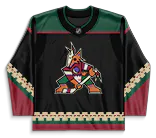Merela will be the odd-man out on Tuesday as the Lightning are opting to dress seven defensemen. He has just one goal and no assists in 17 games this season.

Merela will be the odd-man out on Tuesday as the Lightning are opting to dress seven defensemen. He has just one goal and no assists in 17 games this season.

Myers will re-enter the lineup for Tuesday's game as the Lightning are opting to dress seven defensemen. Myers is yet to register a point in four games this season.

According to general manager Daniel Briere "Carter Hart has requested and been granted an indefinite leave of absence citing personal reasons. The club will have no further comment at this time." The 25-year-old netminder will take a leave from the Flyers after posting a 12-9-3 record, 2.80 GAA and .906 SV% in 26 games played in 2023-24.

Lindstrom has played four straight games for the Ducks, tallying zero points, two shots, and four hits. He will be a healthy scratch on Tuesday as Ilya Lyubushkin will draw back into the lineup.

Ilya Lyubushkin will draw back into the lineup on Tuesday, prompting the Ducks to make Hagg a healthy scratch. Hagg has only played two of the last four games for the Ducks, recording three shots and five hits.


Adam Gaudette will be a healthy scratch on Tuesday, allowing Blais to return to the Blues' lineup after a two-game absence. Blais has been held off the scoresheet in seven straight but has registered 16 hits in that stretch.

Mario Ferraro suffered an undisclosed injury on Tuesday that will keep him out of the lineup for some time, allowing Addison to draw back in as his replacement on Tuesday. Addison has been a healthy scratch for the last four games and has been held off the scoresheet in six straight.

Roy did not play on Monday due to personal reasons but will return to the lineup on Wednesday against the Buffalo Sabres. Roy has four points (2G / 2A) in his last nine games.

Van Riemsdyk has been a healthy scratch in two of the last three games but will join Rasmus Sandin as Capitals' blueliners making their return to the lineup on Tuesday. Van Riemsdyk has one point (0G / 1A) in his last seven games while averaging over 18 minutes time-on-ice. Ethan Bear and Alexander Alexeyev are expected to be healthy scratches on Tuesday.

Alexeyev has played three straight games for the Capitals and has been held off the scoresheet while averaging over 16 minutes of time on ice. Ethan Bear will also be a healthy scratch for the Capitals as Rasmus Sandin and Trevor van Riemsdyk will draw back into the lineup.

Bear will exit the lineup for the first time since joining the Capitals team at the end of December. In 11 games, Bear has two points (1G / 1A), 19 shots, and 17 blocks. Alexander Alexeyev will also be a healthy scratch for the Capitals as Rasmus Sandin and Trevor van Riemsdyk will draw back into the lineup.

Ruzicka has been held without a point in 10 straight games and will be a healthy scratch on Tuesday against the St. Louis Blues. Cole Schwindt will draw into the lineup and make his Flames debut.

Schwindt has three NHL games under his belt but has spent the majority of the last four seasons in the AHL. Schwindt was the 81st overall pick of the Florida Panthers in the 2019 NHL Entry Draft and has 20 points (8G / 12A) in 37 games with the Calgary Wranglers of the AHL this season. He win draw into the lineup in favour of Adam Ruzicka.

Dellandrea played his first game in three weeks on Saturday and recorded one assist in 15:01 time-on-ice, but returned to being a healthy scratch on Sunday. On Tuesday, he will draw back into the lineup and play on the fourth line with Radek Faksa and Sam Steel.

Frederick Gaudreau will return from an upper-body injury on Tuesday, prompting Minnesota to make Raska a healthy scratch. Raska played 7:24 time-on-ice in his last outing and recorded five hits.

Harris will be a healthy scratch on Tuesday, allowing Johnathan Kovacevic to draw back into the Canadiens' lineup. Harris played the last 13 games for the Canadiens, registering three points (1G / 2A) in the process.

Justin Barron drew back into the lineup last week in favour of Kovacevic, who has been a healthy scratch the last three games. Kovacevic played 13:18 time-on-ice in his last game and will draw back into the lineup on Tuesday as Barron has been reassigned to the Laval Rocket of the AHL.

Xhekaj played 17 games with the Canadiens earlier this season but has been with the Laval Rocket (AHL) since November. Xhekaj has three points (1G / 2A) and should continue to build on the 2.41 hits per game he is averaging thus far.

Deslauriers played 5:10 time-on-ice in Sunday's 5-3 loss to the Ottawa Senators, recording four hits. Deslauriers ranks second in the league with 136 penalty minutes, only trailing Minnesota's Pat Maroon.
